Update: 21 December 2024
Autism and Mineral Imbalances in Infants
Hiroshi Yasuda and Toyoharu Tsutsui, La Belle Vie Research Laboratory, Tokyo, Japan
This study enlisted 1,967 autistic children aged 0–15 years. Researchers were able to correlate an epigenetic impact of essential nutrient mineral imbalances, and environmental toxicity with Autism Spectrum Disorders (ASDs).
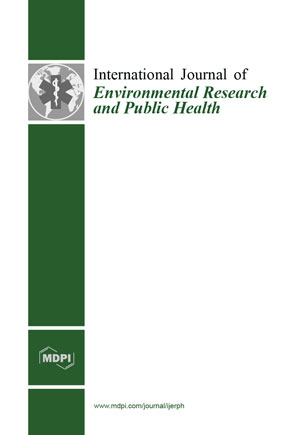
This study was originally published in the International Journal of Environmental Research and Public Health, a peer-reviewed scientific journal that covers the interdisciplinary area of environmental health sciences and public health. It links several scientific disciplines including biology, biochemistry, biotechnology, cellular and molecular biology, chemistry, computer science, ecology, engineering, epidemiology, genetics, immunology, microbiology, oncology, pathology, pharmacology, and toxicology.
Discovery: The ‘Infantile Window’
The interactions between genes and the environment are now regarded as the most probable explanation for autism. We know that nutritional deficiencies and environmental toxicity negatively impact healthy neurologic development. What is new in this report is that the uncovering of another critical factor, the "infantile time window." The report discusses its profound importance in neurodevelopment, and the potential opportunity for therapeutic intervention.
There are numerous studies with the same theme reporting nutritional status and mineral deficiencies in autistic children. However, the conclusions of their studies, in which the restricted age (over 4-years-old) of children and number of minerals were examined, were not consistent, and the critical environmental factors remained to be established.
Autism Spectrum Disorders are a group of neural development disorders characterized by impairments in social interaction and communication, and by the presence of restricted and repetitive behaviors. ASDs continue to increase in prevalence, up to 1 in 88 children and are known to be highly heritable (approx. 90%). However, the underlying genetic determinants are still not clarified, and the interaction of heritable factors with uncertified lifestyle and environmental factors seem to play a significant role in the pathogenesis.
Recently, epigenetic alteration of gene expression by environmental factors is considered one of the key events in the pathogenesis of genetic diseases, and some toxic elements such as cadmium and arsenic have been reported to be candidate factors that induce epigenetic alterations and neurodevelopmental disorders.
Infantile Time Window in Neurodevelopment, and Therapy
The age at final diagnosis of autism spectrum disorders ranges from 3 to 6 years, although most cases of autism are diagnosed by the age of three and as early as 14 months. Zinc deficiency was detected in many of the infantile patients in the first 3 years of life, and high toxic metal burdens were also detected in the autistic subjects, especially in the younger children. Thus, for treatment/prevention of autism spectrum disorders, early screening and estimation is necessary and it is desirable to early check for any metabolic and/or mineral disorders for the infants and children with autistic symptoms. It should be considered that the pathogenesis of neurodevelopment disorders might start in the prenatal phase and be progressive within the time window for diagnosis.
These findings suggest that infantile autistic patients with mineral disorders may respond to a novel evidence-based nutritional approach which supplements deficient nutrients and detoxifies accumulated toxic metals. This evidence-based nutritional approach may yield a new vista into early screening/assessment and treatment/prevention of infantile patients with autism spectrum disorders.
hTMA profile of an autistic child with high levels of cadmium and lead (1 year old boy).
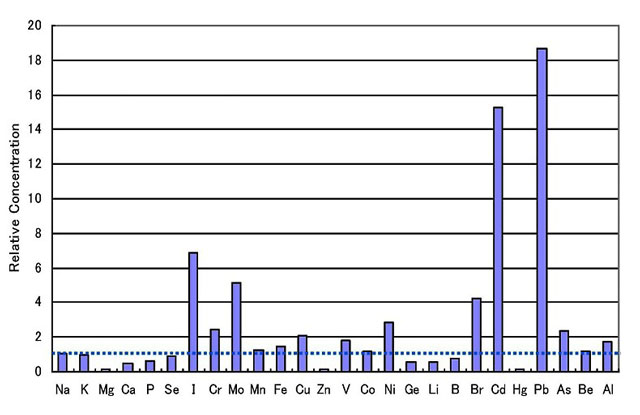
hTMA profile of a 1 year old boy with autism is shown, exhibiting severe zinc and magnesium deficiency and simultaneous high burdens with cadmium (107 ppb) and lead (8.11 ppm). Each bar represents the relative concentration of the respective trace element in his scalp hair specimen. The dotted horizontal line at 1.0 represents the reference control level of each trace element.
hTMA profile of an autistic child with high levels of aluminium (4 year old girl).
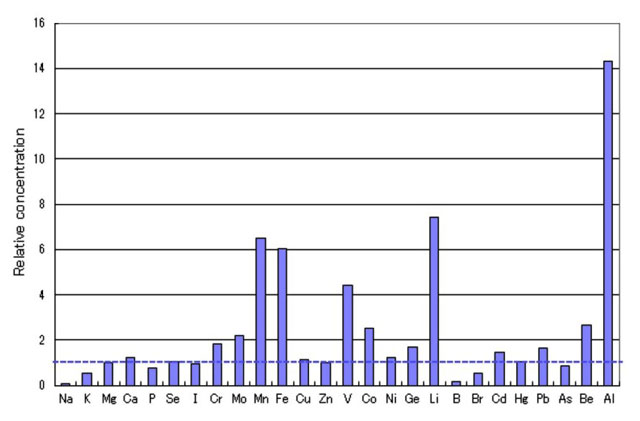
hTMA profile of 4 year old girl with autism is shown, exhibiting simultaneous high burdens with aluminium (53.7 ppm), manganese (702 ppb), iron (37.0 ppm) and lithium (12.2 ppb). Each bar represents the relative concentration of the respective trace element in her scalp hair specimen. The dotted horizontal line at 1.0 represents the reference control level of each trace element.
hTMA profile of an autistic child with high levels of mercury (3 year old boy).
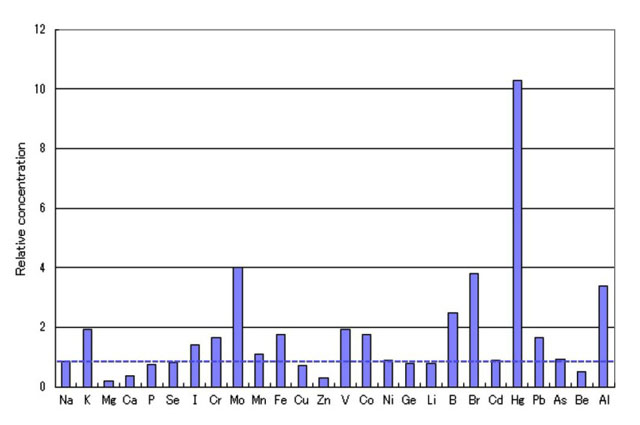
hTMA profile of a 3 year old boy with autism is shown, exhibiting a high burden with mercury of over 10 fold level (40.1 ppm). Each bar represents the relative concentration of the respective trace element in his scalp hair specimen. The dotted horizontal line at 1.0 represents the reference control level of each trace element.
hTMA profile of an autistic child with high levels of arsenic and lead (2 year old boy).
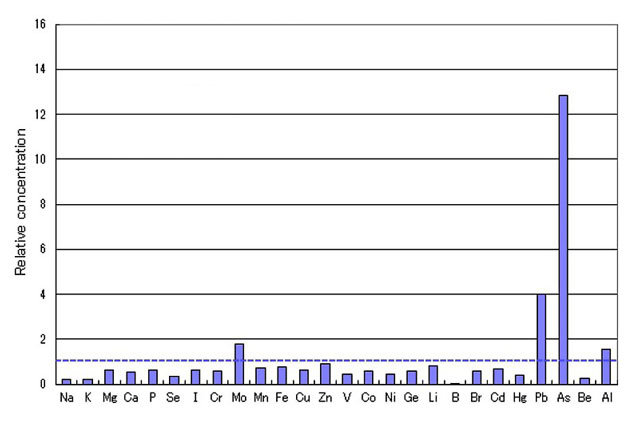
hTMA profile of a 2 year old boy with autism is shown, exhibiting a high burden with arsenic of over 12 fold level (655 ppb). Each bar represents the relative concentration of the respective trace element in his scalp hair specimen. The dotted horizontal line at 1.0 represents the reference control level of each trace element.
hTMA profile of an autistic child with high levels of sodium and potassium (5 year old boy).
Editors note: This example may represent a false autism diagnosis. Similar behavior abberations are commonly caused by high levels of sodium and potassium. A hTMA could confirm this, and with corrective nutritional therapy it would be possible eliminate the abberrant behavior — and reverse the autism diagnosis.
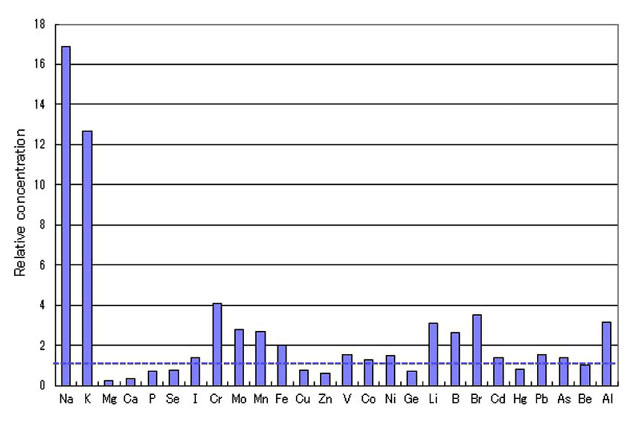
hTMA profile of 5 year old boy with autism is shown, exhibiting simultaneous high levels of sodium (335 ppm) and potassium (210 ppm). Each bar represents the relative concentration of the respective trace element in his scalp hair specimen. The dotted horizontal line at 1.0 represents the reference control level of each trace element.
Download: Full Report
Source: International Journal of Environmental Research and Public Health
Find a hTMA Practitioner